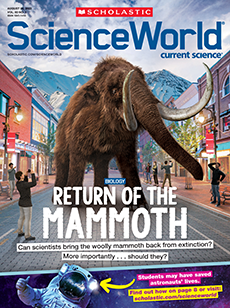Scattered throughout the universe are mysterious dark objects millions or billions of times the mass of our sun. These are the biggest black holes in existence. They sit at the center of galaxies, giant collections of stars—including our home galaxy, the Milky Way. Sometimes galaxies collide. When that happens, their black holes spiral around one another and eventually merge. Scientists think that as these gigantic black holes spin closer and closer to each other, they send out enormous ripples that stretch and compress space.
Last summer, astronomers announced they’d found the predicted gravitational waves rippling through the universe! Researchers are still investigating the giant waves’ origins. Circling supermassive black holes are the leading hypothesis. But it may turn out that the waves come from a source astronomers have never seen before. It’s even possible they were produced 13.8 billion years ago during the big bang—the explosive beginning of our universe.
Scientists around the world are combing through the new data to learn more about these gigantic waves and where they come from. The discovery offers scientists a whole new way to study and understand the universe.
Mysterious dark objects are scattered around the universe. They’re millions or billions of times the mass of our sun. These are the biggest black holes. They sit at the center of galaxies, including our home galaxy, the Milky Way. Galaxies are giant collections of stars. Sometimes galaxies collide. When that happens, their black holes spiral around one another. Eventually, the black holes merge. Scientists think these huge black holes send out enormous ripples as they spin closer and closer to each other. These ripples stretch and compress space.
Last summer, astronomers made an announcement. They’d found the predicted gravitational waves rippling through the universe! Researchers are still studying where the giant waves come from. Those spiraling supermassive black holes are the leading idea. But the waves may come from a source astronomers have never seen. They might even have started 13.8 billion years ago during the big bang. That was the explosive beginning of our universe.
Scientists around the world are studying the new data. They’re trying to learn more about these enormous waves and their source. The discovery gives scientists a whole new way to study and understand the universe.

